Overview
Within This Page
Sustainable buildings start with proper site selection. The location of a building affects a wide range of environmental factors—as well as other factors such as security, accessibility, building energy consumption, and energy consumed by transportation needs of occupants for commuting, impacts on the local ecosystem, and the use/reuse of existing structures or infrastructure. It is therefore important to address site selection very early in the project development process to ensure that issues like solar access and proximity to public transportation are properly considered. Equally important is that whomever selects the project site understands sustainable site design, is sufficiently familiar with the eco-region in which the project is located along with existing and future watershed planning projects that are already in place, and appreciates the impact that site selection has on sustainable design and the building's overall energy performance. If possible, locate buildings in areas of existing development where infrastructure is already in place, and consider conserving resources by renovating existing buildings (including historic properties). It is imperative that building owners and developers maximize the restorative impact of site design and building infrastructure, while also meeting each project's other requirements.
Sustainable site planning should consist of a whole system approach that seeks to:
- Minimize land disturbance through the selection of disturbed land, re-use of brownfield sites, retrofit existing buildings, and minimize new impervious surface creation (parking, building layout, travel lanes, etc.);
- Understand existing watershed plans and environmental goals of the jurisdiction and local watershed organizations that may be regulated;
- Provide wildlife corridors across a large campus whenever feasible. Link natural areas to the greatest extent possible so that contiguous areas allow for undisturbed wildlife movement; Provide a diverse variety of native plants to encourage biodiversity;
- Consider energy implications and carbon emissions in site selection and building orientation;
- Apply best practices for erosion control, through both improved grading and landscaping methods;
- Use native plants and remove any invasive species at the site;
- Reduce the heat island effect by minimizing impervious surfaces, improved landscaping, and by other building design methods;
- Minimize habitat disturbance;
- Reduce, control, and treat surface runoff through effective storm water practices that treat both the quantity and quality of runoff created through the development process;
- Restore the health of degraded sites by improving habitat for indigenous species by planting native and climate-adapted vegetation, rebuilding depleted soil through sustainable organic methods, and by employing closed-loop water systems;
- Locate the building within a walkable distance to a range of other destinations such as places offering goods and services;
- Incorporate transportation solutions into site plans that acknowledge the need for bicycle parking, carpool staging, and proximity to mass transit. Encourage alternatives to traditional commuting;
- Consider site security concurrently with sustainable site issues. Location of access roads, parking, vehicle barriers, and perimeter lighting, among others are key issues that must be addressed;
- Work closely with lighting designer to reduce security lighting and its associated light pollution. With overly bright security lighting, often the "bad guys" can safely stage operations just out of range, invisible to the security personnel whose eyes are adjusted to the overly bright immediate environment. (See also Effective Site Security Design); and
- Respect existing aesthetic view sheds from existing buildings, landscape features, and historic sites.
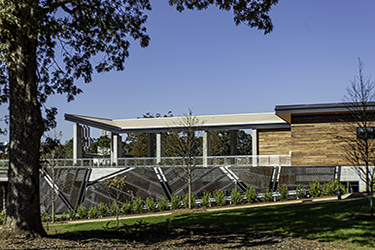
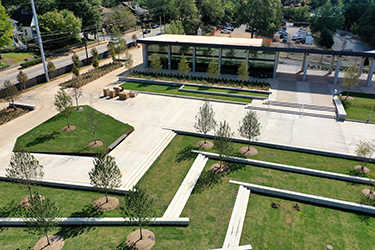
Grant Park Gateway in Atlanta, Georgia is a certified Sustainable SITES Initiative project. Replacing an 8-acre surface parking lot, the Grant Park Gateway offers 1,017 parking spaces topped with a 2.5-acre green roof and 4,000 sf of restaurant space, providing a grand lawn area, a shaded terrace plaza, terraced seating, a water feature, and a pedestrian overpass, as well as a total of 8.6 acres of green space within the SITES boundary. The parking deck is built into the existing landscape with a design inspired by the natural foliage of the park and derived from the veins in leaves.
Photo Credit: The Sustainable SITES Intiative
Recommendations
Minimize Development of Open Space
- Retrofit an existing building. When planning to reuse an existing building, there are things to consider like relocating personnel for major renovations, which may include stripping out all interior finishes and insulation, performing energy audits, and replacing lights, HVAC and windows. (See also Historic Preservation.)
- Use disturbed land or brownfield sites.
Control Erosion Through Improved Landscaping Practices
- Use vegetation, grading, and stabilization techniques to prevent erosion.
- Capture storm-water runoff on-site; design on-site storm-water retention features such as underground cisterns and pervious pavement. See also WBDG Achieving Sustainable Site Design through Low Impact Development Practices.
- Use vegetated swales to direct, slow, and reduce runoff.
Reduce, Control, and Treat Surface Runoff
- Minimize the amount of natural land converted for impervious surfaces such as parking lots, buildings, and travel lanes.
- Apply low impact development principles:
- Install site practices that encourage the natural absorption of rain such as disconnecting roof leaders and using effective storm water practices such as rain gardens, rainwater cisterns, vegetated swales / depressions, constructed wetlands, pervious paving, and other on-site storm water storage methods.
- Understand that the site boundaries for LID extend beyond the building construction site and may include the whole campus, including future construction sites, or even an entire watershed surrounding the building site.
- Use Integrated Pest Management to reduce water pollution from pesticides.
- Consider incorporating green roofs into the project where feasible.
- Plan for extreme storm-water events in the overall management of surface water runoff.
- Follow EPA's Green Infrastructure policy for managing storm-water.
Consider Energy Implications in Site Selection and Building Orientation
- Orient buildings to be able to integrate passive and active solar strategies. If renovating / retrofitting an existing structure where passive solar strategies are not possible within the structure, consider planting trees to shade areas of the building that get more sunshine. Coordinate sustainable site design with site security considerations, including Crime Prevention Through Environmental Design (CPTED) strategies.
- Take advantage of natural ventilation and prevailing wind patterns.
- Maximize daylight use, but balance this against higher heating and cooling demand resulting from increased glazing.
- Investigate the potential impact of future adjacent developments to the site (e.g., solar and wind exposure, daylighting, ventilation, etc.).
- Recycle existing pavement and demolition materials.
- Provide bike racks and electric vehicle charging stations.
Reduce Heat Islands Using Landscaping and Building Design Methods
- Minimize the creation of hard surfaces such as buildings, parking lots, and travel lanes.
- Maximize the use of existing trees and other vegetation to shade walkways, parking lots and other open areas. Ensure that site work and landscaping are integrated with security and safety design. For Crime Prevention Through Environmental Design (CPTED) see also WBDG Balancing Security/Safety and Sustainability Objectives and Security for Building Occupants and Assets. Integrate landforms and landscaping into the site planning process to enhance resource protection.
- In hot, dry climates like the southwestern states, consider covering walkways, parking lots, and other open areas that are paved or are made with low reflectivity (i.e. dark) materials. Ensure that shading devices do not block critical ground level sight-lines, for security.
- Finish the facility's roof with materials that have high reflectivity and high emissivity, to reduce energy loads and extend the life of the roof, particularly in warm climates; and consider incorporating green roofs or photovoltaics into the project. Use a roofing product that meets or exceeds Energy Star standards.
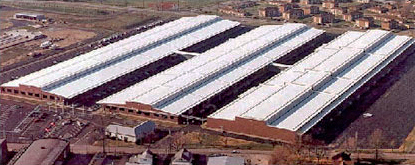
Energy Star® Roof-compliant, high-reflectance, and high emissivity roofing can lower roof surface temperature by up to 100°F, decreasing the amount of heat transferred into a building.
- Consider incorporating green roofs into the project, which bring additional site benefits, including controlling storm water runoff and improving water quality. There are related sustainable site benefits of green roofs. They include:
- Controlling storm water runoff
- Improving water quality
- Mitigating urban heat-island effects
- See also WBDG Extensive Vegetative Roofs and the EPA Heat Island Effect.
Employ Environmentally Preferable Landscaping Practices
- Minimize site disturbance.
- Eliminate the use of potable water for irrigation by designing the landscape with drought-tolerant native / indigenous plants.
- Employ zone irrigation, drip irrigation and rain-water detectors to minimize water consumption in the landscape.
- Budget water resources to match project and site sources, including reuse of treated wastewater or rainwater for irrigation.
- Develop a Pest Control Plan which includes information about: materials and equipment for service; methods for monitoring and detection; service schedules for each building or site; any structural or operational changes that would facilitate the pest control effort; and commercial pesticide applicator certificates or licenses.
- Consider composting and/or recycling yard waste.
- Use only non-toxic outdoor fertilizers and pesticides, where fertilizers or pest management are essential.
- Use landscaping products with recycled content, as required by EPA's Comprehensive Procurement Guidelines (CPG) for landscaping products.
- See also WBDG Sustainable O&M Practices.
Minimize Habitat Disturbance
- Keep land disturbance to a minimum and retain prime vegetation features to the maximum extent possible.
- Implement low-impact site development best practices.
- Reduce building and paving footprints.
- Limit site disturbance to a minimal area around the building perimeter, including locating buildings adjacent to existing infrastructure.
- Plan construction staging areas with the environment in mind.
- In northern climates, locate parking and pedestrian areas so that they have adequate sun exposure to melt snow / ice.
- Use non-toxic snow and ice removal methods. See also PROACT Fact Sheet on de-icing .
Restore the Health of Degraded Sites
- Focus on restoration of degraded areas and on increasing healthy habitat(s) for native species.
- Conserve water use through xeriscaping with native plants. See also WBDG Sustainable—Protect and Conserve Water.
Design for Sustainable Transportation
- Locate the building with public transportation access in mind, and limit on-site parking.
- Locate the building within a reasonable walking distance from destinations that provide goods and services.
- Use porous (pervious) alternatives traditional paving for roads, parking areas, patios and walkways.
- Make provisions for bicycling, walking, carpool parking, and telecommuting; and provide refueling/recharging facilities for alternative fuel/electric vehicles (or at least plan for their incorporation at a later date).
- Where sidewalks are not provided by the local jurisdiction, provide sidewalks along all adjacent public ways so that no one has to walk in the street when passing by the building.
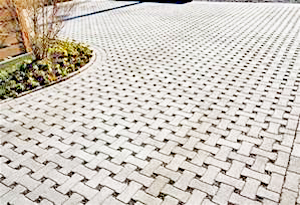
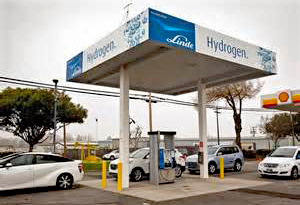
Pervious pavers
Hydrogen refueling station
Balance Site Sustainability with Site Security/Safety
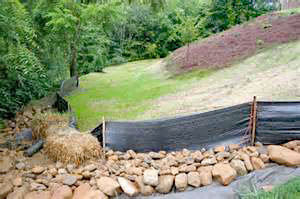
Silt fence used for erosion control measures
- Consider installing retention ponds and berms to control erosion, manage storm water, and reduce the heat island effect, while also serving as physical barriers to control access to a building.
- Use native or locally adapted trees to improve the quality of the site and provide visual screening of assets and people.
- Implement erosion control measures to stabilize the soil (e.g., seeding and mulching, installing pervious paving) and/or to retain sediment after erosion has occurred (e.g., earth dikes and sediment basins). These help to reduce the negative impacts on water and air quality as well as mitigate potential damage to a building's foundation and structural system due to floods, mudslides, torrential rainstorms, and other natural hazards.
- See also WBDG Balancing Security/Safety and Sustainability Objectives.
Smart Growth
Smart Growth is an issue that concerns many communities around the country.
It relates to controlling sprawl, reusing existing infrastructure, creating walkable neighborhoods, and locating places to live and work near public transportation.
It is more resource-efficient to reuse existing roads and utilities than to build new ones which are far out from cities in rural areas.
Smart growth preserves open spaces and farm land, strengthens the development of existing communities and improves their quality of life.
Emerging Issues
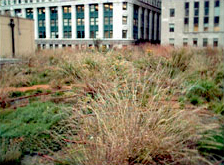
Green roofs can effectively absorb most rainfall events, reverse the urban heat island effect, and provide wildlife habitat. Chicago City Hall. Chicago, IL.
Photo Credit: Don Horn
As global climate change increases storm events and changes ecosystems, sites are now more frequently threatened with damage from flooding, wind erosion and damage, abnormal temperatures, etc.
Consider selecting a site that will limit the intended building's potential damage from global climate change.
Hydrology of site to predevelopment conditions (EISA); energy reduction potential of site; how to use the site to maximize energy development in balance with preserving habitat.
Relevant Codes, Laws, and Standards
Codes and Laws
- Energy Independence and Security Act of 2007
- Executive Order 12072, "Federal Space Management"
- Executive Order 13006, "Locating Federal Facilities on Historic Properties in Our Nation's Central Cities"
- Executive Order 13693, "Planning for Federal Sustainability in the Next Decade"
- International Green Construction Code (ICC IgCC), International Code Council
Standards
- ASTM E2843 Standard Specification for Demonstrating That a Building is in Walkable Proximity to Neighborhood Assets
- ASTM E2844 Standard Specification for Demonstrating That a Building's Location Provides Access to Public Transit
- PBS-P100 Facilities Standards for the Public Buildings Service, General Services Administration (GSA)
- UFC-1-200-02 High Performance and Sustainable Building Requirements
- UFC 3-201-02 Landscape Architecture
- UFC 3-210-10 Low Impact Development
Additional Resources
Minimize Development of Undeveloped Open Space
- EPA Directive 9610.17—Use of Risk-Based Decision-Making in Underground Storage Tank Corrective Action Programs, March 1995.
- EPA Green Infrastructure—a strategic approach to conservation that addresses the ecological, social and economic impacts so communities can better manage stormwater.
- Maryland Department of the Environment, Brownfields Redevelopment Initiative
- Smart Growth Online
Control Erosion through Improved Landscaping Practices
- EPA Green Infrastructure—Low Impact Development
- GSA PBS-P100 Facilities Standards for the Public Buildings Service Chapter 2, Landscape Requirements
- Xeriscape Colorado by Colorado WaterWise
Reduce, Control, and Treat Surface Runoff
Consider Energy Implications in Site Selection and Building Orientation
- Executive Order 13834, "Efficient Federal Operations"
- The Greenest Building: Quantifying the Environmental Value of Building Reuse , National Trust for Historic Preservation
Reduce Heat Islands Using Landscaping and Building Design Methods
- Energy Star® Labeled Roof Products, EPA
- Green Roofs for Healthy Cities
- Greenroofs.com
- Heat Island Group, Lawrence Berkeley National Laboratory
Employ Environmentally Preferable Landscaping Practices
- Integrated Pest Management (IPM) Principles, EPA
- Invasive Plant Atlas of the United States
- Invasive Species Databases, USDA
- Landscaping with Native Plants, EPA
- Water, Wetlands and Wildlife, Federal Highway Administration
Minimize Habitat Disturbance
- International Astronomical Union (IAU)—Controlling Light Pollution
- International Dark-Sky Association (IDA)—IDA's mission is to preserve and protect the nighttime environment and our heritage of dark skies through quality outdoor lighting. IDA has many resources and information on outdoor lighting and light pollution prevention.
- National Wildlife Federation
Restore the Health of Degraded Sites
- Xeriscape Colorado by Colorado WaterWise
Design for Sustainable Transportation
- The Centre for Sustainable Transportation, at the University of Winnipeg—The Centre for Sustainable Transportation was founded to provide leadership in achieving sustainable transportation in Canada.
- Sierra Club, Stop Sprawl Campaign, Transportation Issues
- Zion National Park Case Study by National Renewable Energy Laboratory.
As part of redesigning the visitors' experience at Zion National Park, clean running propane buses were designed to shuttle the park's 2.5 million annual visitors throughout the area. Automobile traffic, which was causing damage to the air and ecosystem of the park, was minimized.
Smart Growth
- The National Center for Smart Growth
- Smart Growth, EPA
- Smart Growth Online
- Smart Location Database and Smart Location Calculator
- Urban Land Institute
Others
- FedCenter.gov—FedCenter, the Federal Facilities Environmental Stewardship and Compliance Assistance Center, is a collaborative effort between the Office of the Federal Environmental Executive (OFEE), the U.S. Army Corps of Engineers Construction Engineering Research Laboratory, and the U.S. EPA Federal Facilities Enforcement Office, a one-stop source of environmental stewardship and compliance assistance information focused solely on the needs of federal government facilities.
- Federal Leadership in High Performance and Sustainable Buildings Memorandum of Understanding
- SITES - The Sustainable Sites Initiative








